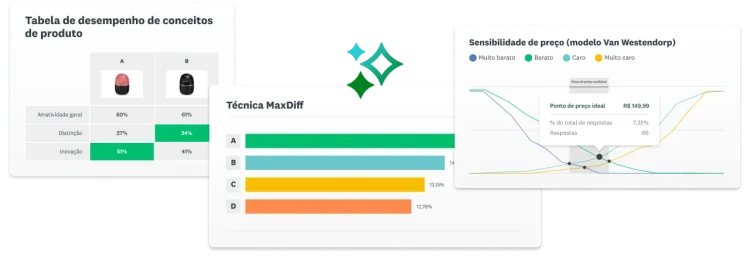
SOLUÇÕES DE PESQUISA DE MERCADO
Obtenha insights gerados por IA com nossas soluções ágeis de pesquisa de mercado
Tome decisões melhores com insights do mercado, do seu setor ou de compradores. Crie uma conta gratuita e comece a colher feedback rápido.





Com a SurveyMonkey, é fácil e rápido fazer suas próprias pesquisas de mercado
Decida quem você quer que responda à sua pesquisa
Escolha seu público para obter um orçamento. Nós enviaremos sua pesquisa a pessoas do nosso painel global que correspondam aos seus critérios. Tenha acesso às opiniões de mais de 335 milhões de pessoas, tanto consumidores quanto profissionais, em mais de 130 países.
Deixe a IA fazer o trabalho pesado por você
A SurveyMonkey usa IA para acelerar e auxiliar em cada etapa da sua pesquisa, guiando o processo de criação da pesquisa e identificando tendências e padrões nos seus dados.
Obtenha insights rapidamente para tomar decisões melhores
Nossa plataforma intuitiva torna fácil coletar e analisar dados em larga escala. Um alto padrão de qualidade de dados garante a precisão dos seus resultados. Além disso, com os relatórios personalizados e a exportação de dados, você pode compartilhar insights prontos para apresentar rapidamente.
SOLUÇÕES CRIADAS POR ESPECIALISTAS
Entenda seu público-alvo, fique à frente do mercado e expanda sua marca
Descubra novas oportunidades e mantenha sua competitividade em um mercado em constante evolução
Saiba mais sobre as preferências, os hábitos e os comportamentos de compra dos consumidores.
Otimização de preços (modelo Van Westendorp)
Encontre o ponto e o intervalo de preço ideais para seu produto ou serviço.
Tome decisões melhores sobre seus produtos e suas mensagens de marketing.
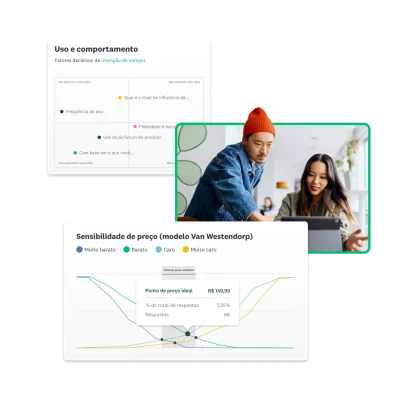
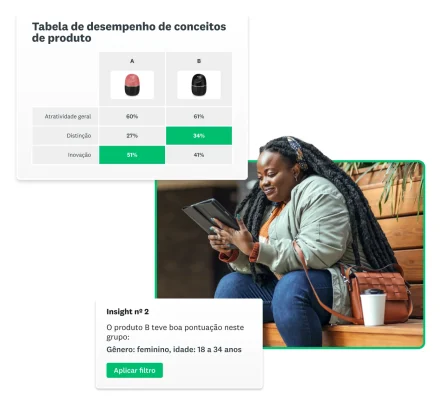
Teste ideias antes de investir e receba o aval da sua liderança mais rápido
Teste ideias de produtos e compare com os referenciais do setor.
Teste rapidamente e priorize ideias de produto ou de marketing com seu público-alvo
Teste diferentes nomes para sua marca, produto ou serviço.
Descubra o logotipo ideal para sua marca ou produto.
Saiba o que seu público-alvo pensa sobre o design de suas embalagens.
Lance campanhas de marketing vencedoras e entre no mercado com confiança
Teste suas campanhas de marketing e propaganda antes do lançamento.
Receba feedback sobre suas mensagens, slogans, textos de produtos e muito mais.
Veja como seus vídeos podem atrair seu público-alvo.
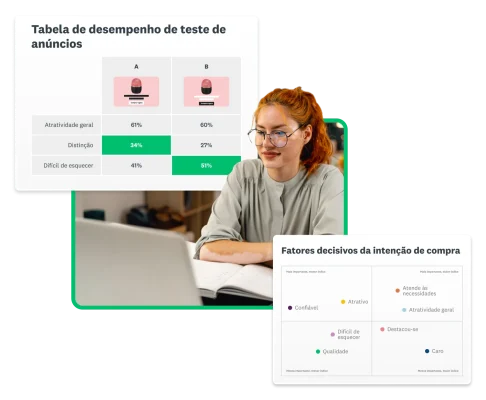

Obtenha insights do seu mercado-alvo em questão de minutos
Obtenha insights de nosso painel de mais de 335 milhões de pessoas selecionadas em mais de 130 países, com mais de 200 opções de segmentação. Nós limpamos seus dados automaticamente e removemos respostas de baixa qualidade, para que você possa tomar decisões com confiança com base em insights de qualidade.
Descubra mais recursos para melhorar suas pesquisas
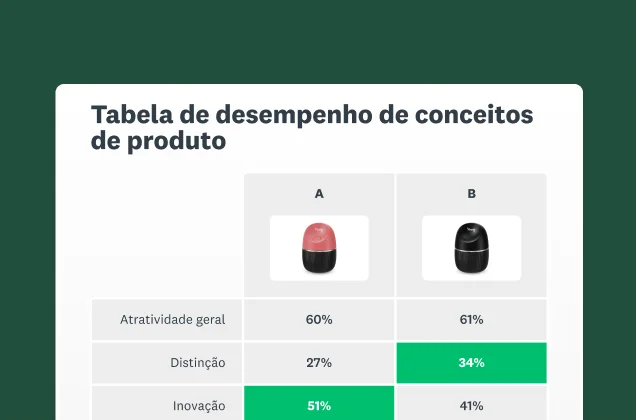
As 5 fases do ciclo de vida do produto
Teste seus produtos antes de lançá-los com as soluções de teste de conceito da SurveyMonkey.

O que acontece quando você inicia um projeto no SurveyMonkey Audience
Saiba o que esperar quando seu projeto estiver no ar e recebendo respostas.

O que há de novo na SurveyMonkey?
Saiba tudo sobre nossas últimas atualizações de produtos e recursos. Crie questionários e formulários para obter feedback rápido e insights impactantes.

Testamos a qualidade do nosso painel de respondentes do Audience
Como nossa equipe de pesquisa garante respostas coerentes e bem pensadas.
Fique à frente da concorrência
Posicione-se no mercado com confiança com nossas soluções de pesquisa de mercado criadas por especialistas.